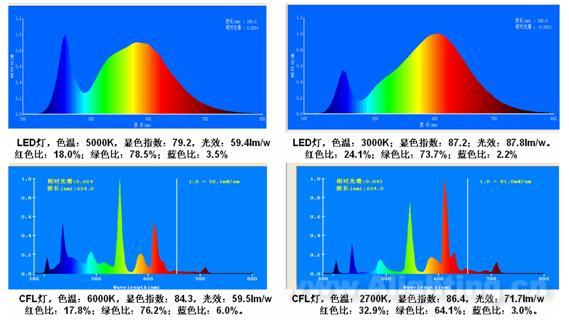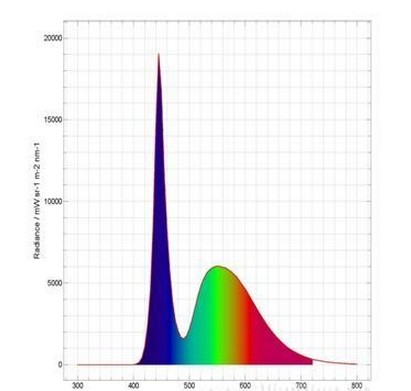In an earlier report, Shanghai Institute of Quality Inspection and Technical Research (SQI) tests conducted on 27 LED luminaires showed most were safe to use and had low blue-light hazards. In the second part of the LED lighting product’s blue-light hazard detection, blue-rich light analysis and recommendation report” by Yu Anqi, Vice Presidentreport of SQI offers recommendations to LED manufacturers in China.
Recommendations
Photobiology safety (including blue-light hazard) can impact human health and lighting product regulations, such as national standards should be mandatory. However, China’s GB/T 20145-2006 standard for photobiological safety of lamps and lamp systems is only a recommended standard. This standard should be made mandatory and included in The China Compulsory Certificate (CCC) mark for luminaires.
Blue-rich lighting impact on human circadian rhythm
How do LED luminaires free of blue-light hazards under international standard tests fare in blue-rich light impact human circadian rhythm?
Over million years of human evolution, human circadian rhythm have become accustomed to “working in the day, and resting at night.” Research have shown this kind of biological reaction is closely related to visual cells reception of brain signals. Using high color temperature lighting from morning to evening can improve work efficiency.
By nightfall, though, most residential lighting require low color temperature lights that signals the human body it is about time to rest.
Table 1. Natural lighting changes represented in luminaire color temperature.
|
Time Period |
Color Temperature |
|
Morning and evening |
2,000K-3,000 K (warm white light) |
|
Morning (8:00 AM) |
4,000K (cold white light) |
|
Around noon |
5,000K-6,000K (sunlight) |
In SQI’s recent test of 27 LED luminaire samples, seven samples had a color temperature over 6,500K, and there was even one product exceeding 100,000K. While these products do not pose blue-light hazards, it can cause circadian rhythm disruptions. According to studies in China, for people with sleep disorders even a luminaire with a color temperature range between 5,000K~6,000K are not entirely suitable for night time illumination.
Spectrum test comparison between good quality LED lights and CFL
The image below compares LED luminaire and CFL spectrum tests. The image on the left is a comparison of cold temperature spectrum. LED luminaires with a color temperature below 1,000K has to maintain luminous efficiency to reach CRI requirements, while the two types of lights have about the same amount of red and green light emissions. In the blue light range, LEDs even emit less blue light than CFL.
Image 1. High quality LED luminaire and CFL spectrum comparison
 |
|
[Left side of the image shows cold white color temperature test results.]
Top left: LED light sample with color temeprature of 5,000K, CRI 79.2, luminous efficacy of 59.4 lm/w. Color ratio red: 18.0%, green light: 78.5%, blue light: 3.5%.
Bottom left: CFL lamp with color temperature of 6,000K, CRI 84.3, luminous efficacy 59.5 lm/w, and color ratio of red 17.8%, green 76.2%, blue light 6.0%.
[Right side of the image shows warm white color temperature test results.]
Top right: LED light sample with color temperature of 3,000K, CRI 87.2, luminous efficacy 87.8 lm/w, and color ratio of red 24.1%, green 73.7% and blue light 2.2%.
Bottom right: CFL lamp with color temperature of 2,700K, CRI 86.4, luminous efficacy 71.7 lm/w. Color ratio: red 32.9%, green 64.1%, blue 3.0%. (Image Courtesy of SQI/SALT)
|
The warm color lighting comparison in the right image shows LED luminaire color temperature tends to be 300K higher than CFL. Although, CFL tends to peak in the red light range in the spectrum test, the blue light levels are still slightly lower compared to LED. It can be observed using current manufacturing technology, blue light levels in LED luminaires that maintain a CRI above 80, and color temperature of below 4,500K are not particularly higher than same kind of CFL luminaires.
Spectrum test comparison of low quality lights
Image 2. Low quality LED luminaire spectrum test results
 |
|
Low quality LED luminaire spectrum test results. (Image Courtesy of SQI/SALT) |
The image aboves shows spectrum test results of LED products with poor quality phosphor powder formula and coating. The most obvious feature is these products color temperature reaches 8,563K (normal lighting color temperature falls in 6,500K). Another evident characteristic were these products R9 value was -17.8. According to U.S. Energy Star standards a luminaire’s R9 value, an index representing red color range, must be above 0. Currently, most lighting products found in Shanghai’s Qiujiang Rd. Market including LED table lamps, emergency lighting, car garage lights and electric vehicles head lamps fall in this spectrum range. Luminaires with these spectrum results cannot be used for lighting, especially for residential, office and commercial lighting. The fact these types of LED lighting products exist damage the industry’s reputation, and disrupts the LED lighting market. According to conclusions arrived at the 249th China Association for Science and Technology (CAST)’s Youth Scientist Forum based on new international research “blue-rich” light can affect human health.
Currently, the Chinese government is promoting advantages that certified energy efficiency LED products have sover conventional lighting including:
-
LED downlights can realize 3,000K color temperature, and a CRI of 87.2. Under these conditions, these luminaires luminous efficacy can reach 85 lm/w, nearly double that of similar CFL downlights.
-
LED and PAR luminaires color temperature reached 3,000K to 5,000K and a CRI 85. When all requirements are met the luminous efficacy can reach about 50 to 65 lm/w, nearly double or triple that of same kind of halogen PAR luminaires.
-
Omnidirectional LED bulbs installed in a room that meet a normal incandescent bulb range, have a color temperature of 3,000K, CRI 87.2, and energy efficacy of 85 lm/w.
-
Tunnel lighting upgraded to LED luminaires were able to take advantage of dimming properties, and were 15 to 20 percent more efficient then fluorescent lamps using primary colors, or HID luminaires. Increased LED luminaire lifetime also greatly lowered maintenance, bringing personnel costs to about 35 percent that of conventional lighting.
Conclusion and recommendations
-
Blue-light hazard and “blue-rich light” are not exclusive to LEDs, and were present in metal halides and fluorescent lamps.
-
To correctly differentiate between blue-light hazard and “blue-rich light, ” the former indicates when blue light radiance reaches Class 2 or Class 3 under GB/T 20145-2006/CIE S009/E:2002 standards; it can create retinal damage in a short period of time or immediately. The standard is based on the CTL-0744_2009-laser decision. However, blue-rich light refers to lighting impact on human health and circadian rhythm, which currently is on top of global research agenda and can take years of research before its impact can be fully understood. There are currently no related standards for blue-rich light, although many research reports have been released.
-
Currently, some people in China think the GB/T 20145-2006/CIE S009/E:2002 standard that has been implemented for a very long time in China might be outdated. However, the standard is still effective internationally in developed countries and other regions. The international standards are established after large volumes of data and analysis are gathered from experiments. China has not systematically tested LEDs or conducted any research on a similar scale. Any claim that the standards are outdated is inappropriate, but further attention is required in amending China’s LED luminaire standards.
-
Under normal usage conditions, indoor lighting can only use LED lighting products that have a blue-light hazard ranking of Class 1 or below. For special groups including diabetes patients and photosensitive patients, or those that might be directly gazing at LED lights due to particular position (such as infants), lighting products free of blue-light hazards should be used instead.
-
Blue light is a key component to white light emissions, filtering blue light under normal conditions is just a partial explanation to a solution. The correct method would be choosing the correct lighting and quality to accommodate human circadian rhythm. To avoid blue-light rich LED lighting products from negatively impacting human health, indoor LED lighting color temperature should not exceed 4,000K. Average CRI should meet above 80, and luminaires with color temperature above 5,000K should be avoided from being used indoors. Currently, low color temperature LED product technology and costs already meet the above requirements.
-
Returning to nature and designing products with lighting similar to the natural light, color temperature and variations will be the pinnacle of manufacturing plus luminaire and lighting design. Lighting for particular groups and venues must be dimmable, and reach a reasonable color temperature within approved spectrum range. In this aspect, LED’s dimmable features has always been its greatest strength.





 CN
TW
EN
CN
TW
EN





